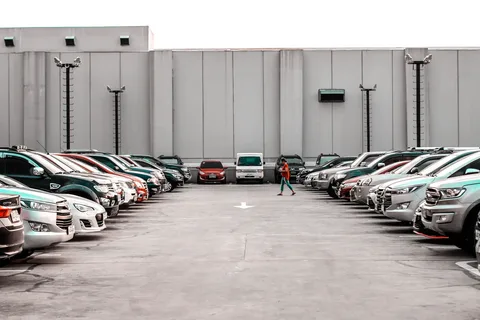Table of Contents
Understanding the Urban Parking Dilemma: Why Space Management Matters
The Historical Context of Parking in Urban Spaces
The evolution of urban parking has always mirrored the growth and transformation of cities. In the early 20th century, as automobiles emerged as symbols of freedom and progress, cities adapted their landscapes to accommodate this new mode of transport. Initially, parking was seen as a simple necessity; streets lined with vehicles and open spaces dedicated to parking were commonplace. However, as urban populations burgeoned and traffic congested, this once straightforward relationship became complex. By the mid-20th century, the demand for parking intensified, leading urban planners to rethink their strategies. Streets were redesigned, multi-storey car parks emerged, puzzle parking systems were introduced to maximize limited space, and zoning laws were implemented. Yet, many urban areas found themselves unprepared for the consequences of these adaptations, including increased traffic congestion, air pollution, and a diminished quality of life. Recognizing this historical context is crucial to understanding the intricacies of current urban parking challenges and solutions.
Economic Impacts of Efficient Parking Management
Efficient parking management extends far beyond ensuring that vehicles have spots; it significantly influences local economies. The cost of inefficient parking practices translates to lost revenue for businesses, higher operational costs for city councils, and increased burdens on public infrastructure. For instance, studies show that when parking is scarce or poorly managed, shoppers are less likely to visit urban centers, opting instead for suburban malls with ample parking. This not only affects retail revenues but also results in reduced sales tax income for municipalities. Conversely, effective parking management increases overall economic vitality. Dynamic pricing, for example where parking rates adjust based on demand can lead to optimized usage of spaces, decreased congestion, and subsequently heightened consumer satisfaction. Such strategies not only help businesses flourish but also enhance city revenues, thereby justifying the investments in infrastructure needed to support these systems.
Environmental Considerations and Sustainable Practices
In recent years, sustainability has taken center stage in urban planning discussions, particularly regarding transportation and parking policies. Inefficient parking leads directly to environmental degradation; vehicles circling for spots contribute to unnecessary emissions, while sprawling parking lots consume valuable green spaces. Urban areas must therefore prioritize environmentally conscious practices in their parking strategies. For example, green parking initiatives, such as pervious paving that allows rainwater absorption, reduce runoff and promote sustainability. Furthermore, cities are exploring the integration of solar panels in parking garages, generating renewable energy and minimizing reliance on fossil fuels. By emphasizing sustainable practices, urban planners can foster a more resilient and ecologically friendly city infrastructure. Moreover, the broader environmental implications of better parking management resonate well with community interests, as cities confront the challenges of climate change and pollution.
Innovative Solutions for Urban Parking: What’s Driving Change?
Smart Parking Technologies: How Apps are Revolutionizing Space Management
The introduction of smart technologies has revolutionized urban parking, transforming how cities allocate and manage space. Applications and devices equipped with IoT (Internet of Things) technology allow drivers to find available spots in real-time, drastically alleviating the stress of parking. Such innovations harness data analytics to predict parking availability while also allowing for mobile payments, further enhancing the user experience. Cities like San Francisco and New York have pioneered smart parking meters that adjust fees based on demand, encouraging turnover and maximizing space utilization. Beyond immediate convenience, these technologies also contribute to longer-term urban planning by collecting vital data to help city officials assess peak usage times, spot patterns in parking behavior, and forecast future demands more accurately. In this way, smart parking applications foster a symbiotic relationship between technology and urban infrastructure, leading to a seamless transition into the digital age.
The Role of Autonomous Vehicles in Redefining Parking Norms
As the era of autonomous vehicles (AVs) approaches, the implications for urban parking are profound. The adoption of AV technology promises not only to change driving dynamics but to fundamentally alter parking requirements and design. With self-parking capabilities, AVs can maneuver into tighter spaces with exceptional accuracy, thus reducing the size and number of parking spaces needed across urban landscapes. Moreover, if regularly utilized, AVs could lessen the overall demand for parking as ride-sharing applications proliferate. These factors lead city planners to rethink parking garage constructions, opting for vertical spaces, adaptive reuse of existing parking infrastructure, or even entirely reimagining urban areas to be less car-centric. With the rise of AVs on the horizon, cities have an extraordinary opportunity to pivot towards sustainable mobility solutions, realigning their focus from accommodating vehicles to enhancing pedestrian and cyclist experiences.
Designing Multi-Use Spaces: Flexibility in Urban Planning
The concept of multi-use spaces has emerged as a visionary approach to urban design, integrating various activities living, working, shopping, and parking into singular environments. By utilizing innovative architectural and planning techniques, cities can witness the transformation of underutilized areas into vibrant, functional spaces. One exciting example of this trend is the conversion of parking structures into urban parks or recreational areas, even while retaining parking facilities. Such multifunctionality optimizes land use, enhances community interaction, and fosters a greater sense of place. Multi-use spaces can be equipped with amenities that also cater to pedestrians and cyclists, thus promoting sustainable transportation methods and reducing reliance on personal vehicles. This holistic approach results in valuable land conservation, urban connectivity, and a more engaged community providing a comprehensive solution to the traditional parking dilemma.
Strategies for Effective Parking Space Utilization: Tips for City Planners
Implementing Dynamic Pricing Models for Parking Spots
Dynamic pricing models represent a powerful strategy for regulating parking supply and demand. By adjusting pricing based on factors such as time of day, location, and historical data, cities can encourage higher utilization rates while simultaneously managing congestion. For instance, during peak hours, prices can increase to promote turnover, incentivizing short visits while keeping higher-demand areas accessible. This approach has been successfully implemented in various cities worldwide, with notable examples including London and San Francisco. The benefits extend beyond merely maximizing space: vibrant urban life emerges when parking is managed effectively, resulting in decreased traffic, reduced pollution, and an enhanced overall quality of life. Moreover, revenue generated from dynamic pricing can be reinvested into public transport systems, cycling infrastructure, pedestrian pathways, and community services, creating a sustainable urban ecosystem.
The Benefits of Park-and-Ride Systems in Urban Landscapes
Park-and-ride systems have gained traction as a strategic solution to alleviate urban parking woes and improve public transport ridership. These systems allow commuters to park their vehicles at designated lots on the outskirts of a city and transition to public transport systems for the remainder of their journeys. Such initiatives help to reduce inner-city traffic congestion and pollution while simultaneously broadening access to employment opportunities within urban centers. Beyond these environmental benefits, park-and-ride schemes contribute to an integrated transportation network, granting individuals affordable and convenient transit options. Cities like Amsterdam have implemented successful park-and-ride systems that cater to cyclists as well, providing secure bike parking alongside shuttle services. Through continuous engagement with the community and stakeholders, cities can adapt and enhance these systems, creating an environment that prioritizes accessibility and efficiency while fostering a sustainable urban landscape.
Cultivating Community Involvement in Parking Solutions
Successful parking management hinges on active community engagement and participation. Urban planners must recognize the importance of incorporating community perspectives in the decision-making process. Practically, this could involve holding public forums, surveys, and workshops where community members can voice their concerns and ideas on parking strategies. This participatory approach enables planners to develop solutions tailored to the unique needs of the community, ensuring that policies reflect local interests. Moreover, enhancing community awareness around the implications of parking choices can foster collective responsibility. Educational campaigns celebrating alternative transportation options, increasing awareness of the benefits of public transit, cycling, and even carpooling often lead to greater acceptance of new policies. By cultivating an inclusive dialogue, cities can build trust, garner support, and create a more harmonious urban environment.
Future Trends in Urban Parking: Preparing for Tomorrow’s Challenges
The Integration of Public Transit and Parking Infrastructure
As urban populations continue to expand, the integration of public transit and parking infrastructure will play an essential role in shaping future cities. An integrated approach facilitates seamless transitions between different modes of transport, optimizing journeys while alleviating vehicular congestion. Cities that prioritize this symbiosis can expect increased public transport ridership and greater use of shared mobility solutions. To achieve this, planners are increasingly focusing on creating multi-modal hubs that combine bus, rail, bike, and parking services into coherent, easily navigable spaces. For example, transit-oriented developments (TODs) emphasize the proximity of residences and businesses to public transport systems, thereby promoting diminished car dependency. The collaborative efforts of cities to develop user-friendly, integrated transport systems will have a lasting impact on commuting behaviors as urban environments evolve.
Emerging Technologies: What’s on the Horizon for Parking Management?
As technology continues to advance, the future of parking management looks promising, with transformative innovations set to appear on the horizon. The potential incorporation of artificial intelligence (AI) into parking systems can streamline operations by using predictive algorithms to assess parking habits. Furthermore, the emergence of blockchain technology can enhance transparency and efficiency in parking transactions. Concepts such as augmented reality may facilitate real-time navigation options to available parking spots, while developments in drone technologies could even reshape the way vehicles navigate urban settings. Through embracing these technologies, not only can cities improve parking management but also enhance the quality of urban life as a whole, focused on efficiency, sustainability, and user convenience.
Global Case Studies: Successful Approaches from Around the World
Examining global case studies can provide valuable insights into successful parking management strategies. For instance, in Singapore, high demand for parking spaces has led to the implementation of a comprehensive parking management system that utilizes electronic road pricing, dynamic pricing models, and smart apps to streamline parking efficiency. Similarly, cities like Amsterdam have effectively embraced cycling as a means to reduce reliance on personal vehicles, complementing their extensive bike parking facilities with flexible transport options, thereby creating a seamless travel experience. In contrast, in Los Angeles, a city traditionally characterized by heavy car reliance, initiatives such as reducing parking minimums for new developments are fostering a shift towards more sustainable urban growth. Analyzing these diverse approaches helps urban planners identify best practices and tailor strategies best suited for their unique contexts, ultimately paving the way towards enhanced urban mobility.









